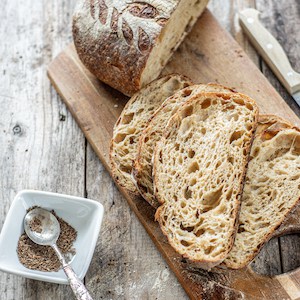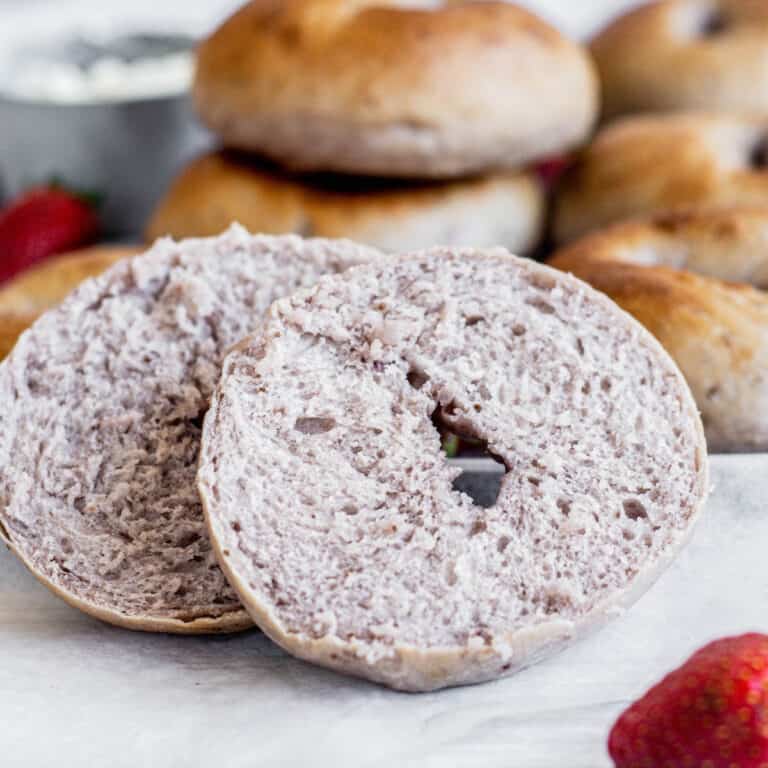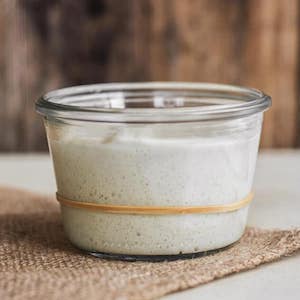Homemade Sourdough Bagel Recipe
This sourdough bagel recipe makes the best thick, chewy, and delicious bagels. Sourdough bagels are one of the easiest sourdough recipes to make. They taste amazing, too, with a great toothsome bite.

These homemade sourdough bagels are made over a period of two days. The dough undergoes two main rising periods, one at room temperature and one overnight in the refrigerator. The long cold proof brings extra flavor to the dough.
It’s a very stiff dough to work with, with a low hydration level. (Work out the dough hydration using this sourdough hydration calculator.) It makes it reasonably easy to knead since the dough isn’t sticky, but it takes a bit of arm muscle! You can also mix the dough on low speed in a stand mixer.
A very similar dough is used in these sourdough pretzels! If you don’t have a sourdough starter yet, check out how to make one in this sourdough starter recipe.
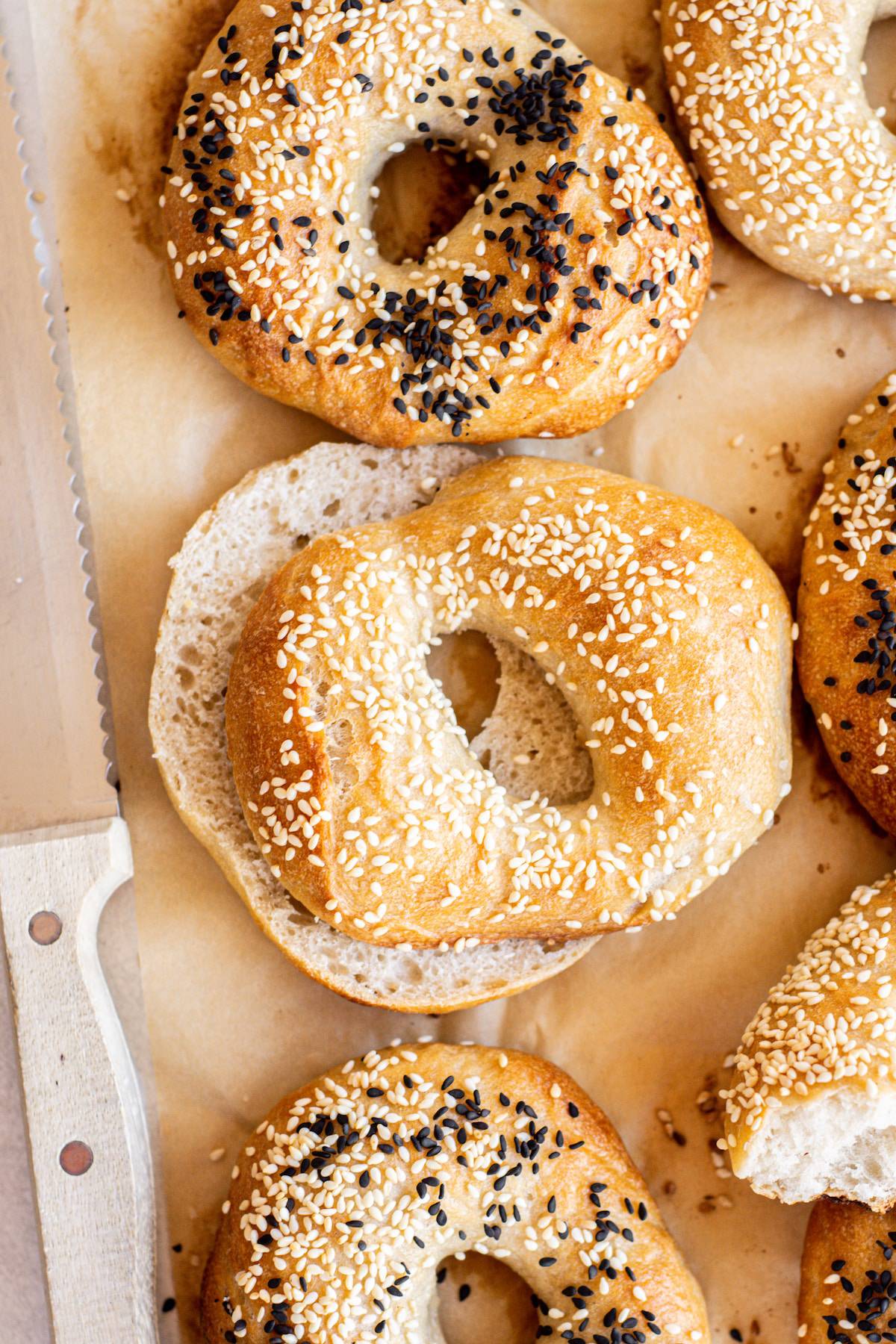
Ingredients
This bagel dough is a lean dough with minimal ingredients. The full ingredient amounts are in the printable recipe card at the bottom of this post. Here’s what you need:
- Strong bread flour – A good bagel has a decent amount of toothsome chew to it. Flour with a higher protein level is required for the chewy texture – a level between 11-13%. Some all-purpose flours have a protein level of over 11% in which case you can use that sort of all-purpose flour for homemade bagels. A higher protein level will give the best chewy bagel results.
- Active sourdough starter
- Salt
- Brown sugar
- Water
- Sesame seeds, poppy seeds, or bagel seasoning for topping
Equipment
- Kitchen scale -to accurately measure the ingredients.
- Large saucepan – for poaching the bagels.
- Slotten spoon – removing the bagels from the poaching liquid.
- Baking sheet pan – to bake the bagels on.
Step by step
- In the morning or the evening before, feed your sourdough starter.
- Once the starter is ready to go, add it to a large mixing bowl with the rest of the dough ingredients and use a fork to combine it into a thick and rough dough.
- Tip the dough onto a lightly floured surface and knead it until it is smooth and strong. For optimal gluten development, the dough needs to be worked and kneaded for around 10 minutes. Alternatively, mix the dough in a bowl of a stand mixer fitted with a dough hook attachment on low speed.


- Once kneaded, place the ball of dough in a lightly greased large bowl, cover the bowl with plastic wrap or a damp tea towel and let the dough rise in a warm spot around 25°C/77°F until bulked out by at least 60%.
- You can create a warm and humid spot by placing the dough in a turned-off oven next to a mug of boiled water. This can take around 5-6 hours in a warm space.
- Once the dough has risen, place it in the refrigerator overnight or for up to 24 hours.
Shaping
- Remove the dough from the refrigerator and pull it from the bowl onto a clean work surface.
- Use a bench scraper or sharp knife to cut the dough into 8 equal pieces. Shape each piece into a tight ball and rest them on a lightly floured work surface. Let the dough rest for 10-15 minutes whilst the glutens relax.
- Once they’ve relaxed, it’s time to give them their bagel shape. Grab a large baking sheet and line it with parchment paper.
- Take a dough ball and use your thumbs to make the hole in the middle of the dough ball and roll the dough ball around your thumbs and index fingers to widen the hole. Make the center hole quite wide because it will shrink back a bit as it rests. Then place it on the baking sheet and continue with the remaining dough balls.
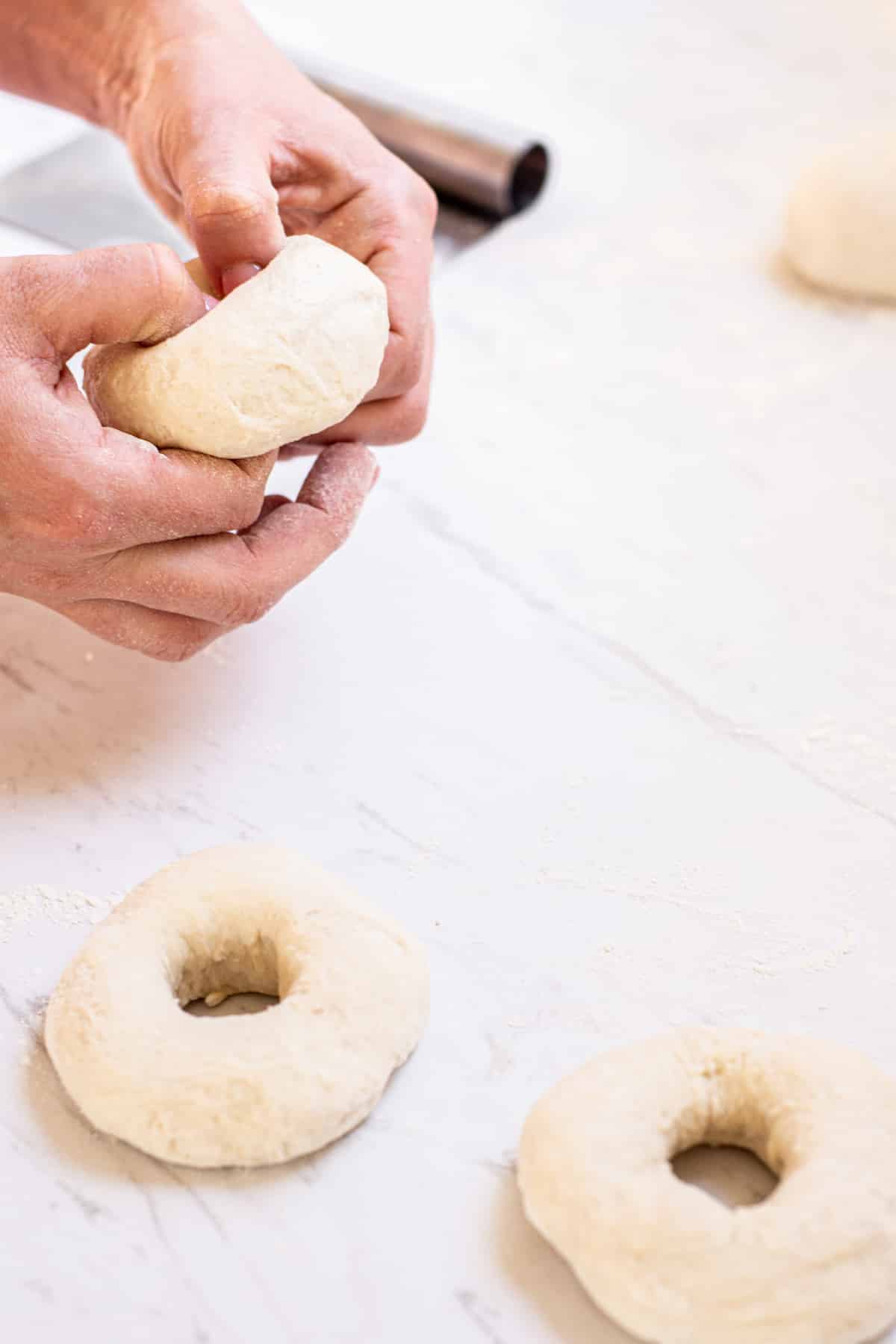
- Let the shaped bagels rise at room temperature for the second time, for around 60 minutes until lightly puffed.
- Bring a large pot of water to the boil and preheat the oven to 428°F/220°C.
Poaching
- Once the water is boiling, stir in honey or brown sugar.
- Dust any excess flour off the bagels and drop them in the boiling water one at a time. If your pot is small, boil them in batches.
- Let them poach in the water for 1-minute total, flipping them after 30 seconds. Remove the bagels from the water using a slotted spoon.
- Drain the boiled bagels on a wire rack and sprinkle over any seeds or bagel seasoning for toppings whilst they are still sticky from the water.
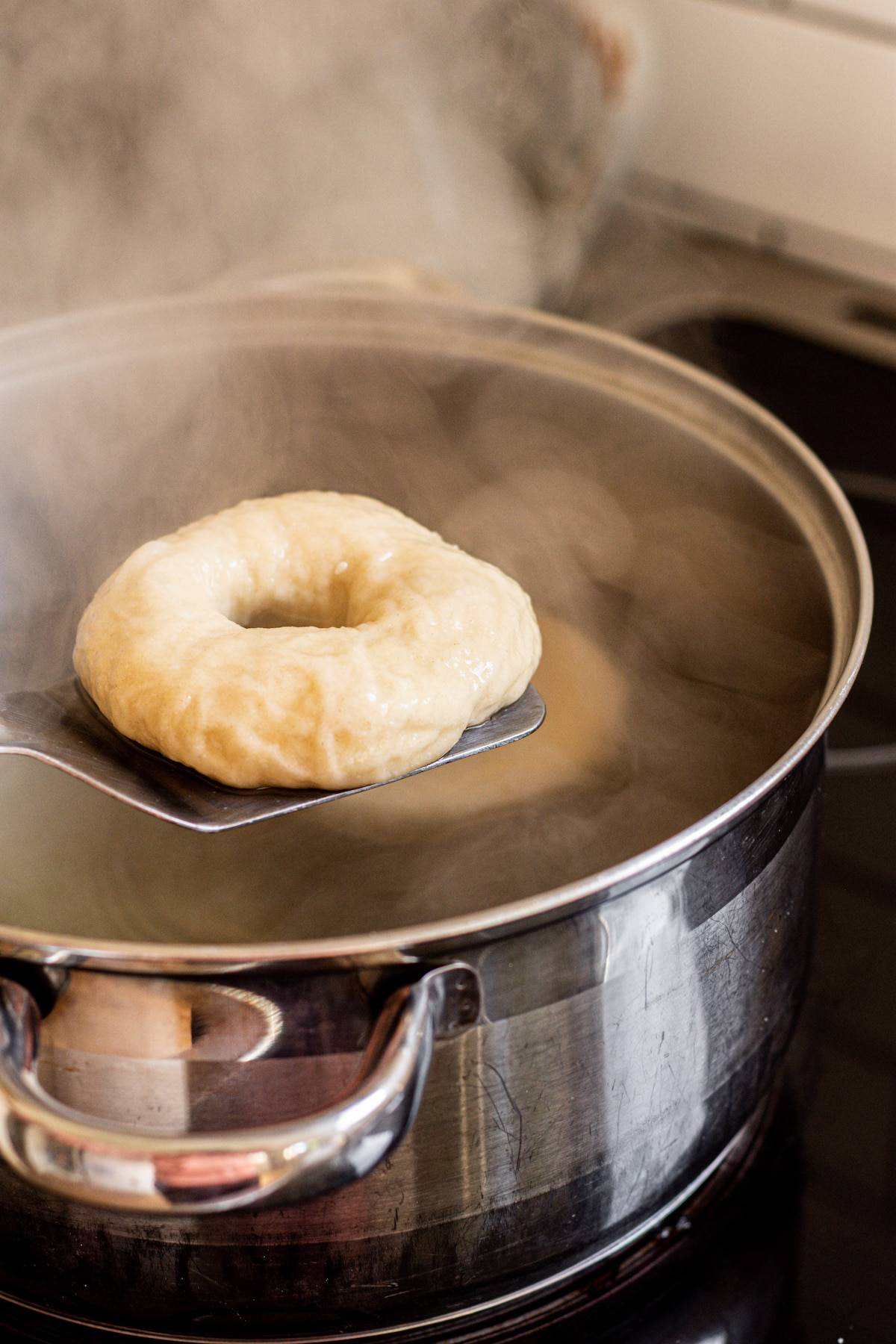
Baking
- Place the bagels on a parchment paper-lined baking sheet. Bake them in the oven for 22-25 minutes until deep golden brown. If they are baking unevenly or your oven has hot spots, turn the oven tray around after 15 minutes of baking.
- Remove the baked bagels from the tray and let them cool on a cooling rack for 30 minutes before slicing and serving. The bagels will initially feel very hard as they come from the oven but will soften as they cool.
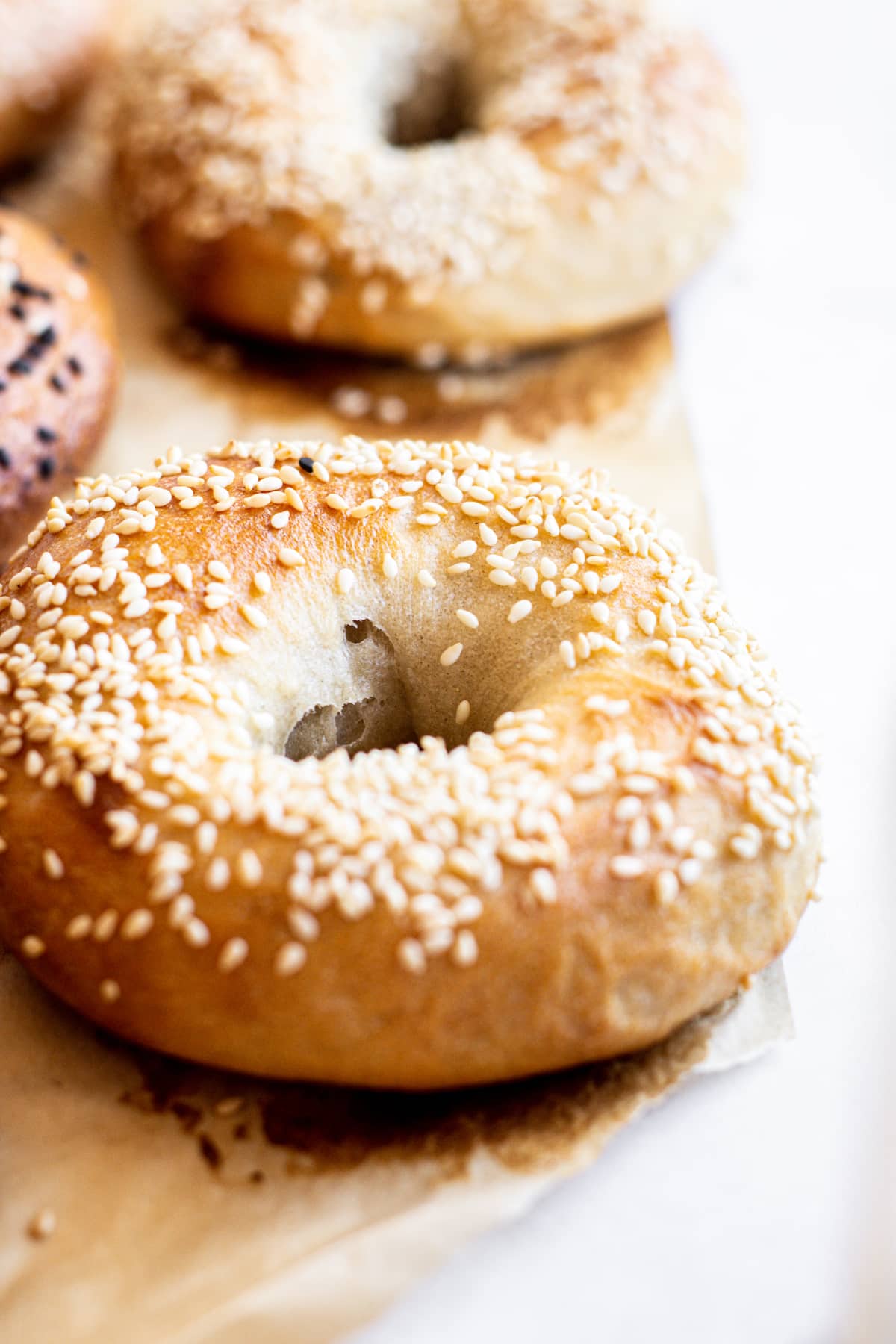
Serving
They are delicious when served fresh on the day, with cream cheese or avocado. When eating them on the following days they are best toasted.
More sourdough recipes
Looking for regular yeast bagels? Check out this overnight bagels recipe.

Sourdough Bagels
These sourdough bagels are thick, chewy, and delicious.
Ingredients
Starter
- 40g starter
- 40g all-purpose flour
- 40g water
Dough
- 440g strong all-purpose flour or bread flour, with a protein level of at least 11%
- 240g water
- All the active sourdough starter
- 12g brown sugar
- 10g salt
Poaching
- 2quarts/1.9L water
- 1 heaped Tablepoon honey or brown sugar
Topping
- Sesame and poppy seeds
Instructions
Starter
- In the morning or the evening before, feed your sourdough starter. (If feeding the starter the night before, see the amounts in the notes below.)
Dough
- Once the starter is ready to go, add it to a large mixing bowl with the rest of the dough ingredients and use a fork to combine it into a thick and rough dough.
- Tip the dough onto a lightly floured surface and knead it until it is smooth and strong. For optimal gluten development, the dough needs to be worked and kneaded for around 8-10 minutes. Alternatively, mix the dough in a bowl of a stand mixer fitted with a dough hook attachment on low speed.
- Once kneaded, place the ball of dough in a lightly greased large bowl, cover the bowl with plastic wrap or a damp tea towel and let the dough rise in a warm spot around 25°C/77°F until bulked out by at least 60%.
- You can create a warm and humid spot by placing the dough in a turned-off oven next to a mug of boiled water. This can take around 5-6 hours in a warm space.
- Once the dough has risen, place it in the refrigerator overnight or for up to 24 hours.
Shaping
- Remove the dough from the refrigerator and pull it from the bowl onto a clean work surface. Form it into a log.
- Use a bench scraper or sharp knife to cut the dough into 8 equal pieces. Shape each piece into a tight ball and rest them on a lightly floured work surface. Let the dough rest for 10-15 minutes whilst the glutens relax.
- Once they've relaxed, it's time to give them their bagel shape. Grab a large baking sheet and line it with parchment paper.
- Take a dough ball and use your thumbs to make the hole in the middle of the dough ball and roll the dough ball around your thumbs and index fingers to widen the hole. Make the center hole quite wide because it will shrink back a bit as it rests. Then place it on the baking sheet and continue with the remaining dough balls.
- Let the shaped bagels rise at room temperature for the second time, for around 60 minutes until lightly puffed. Preheat the oven to 428°F/220°C.
Poaching
- Bring a large pot of water to a boil.
- Once the water is boiling, stir in honey or brown sugar.
- Dust any excess flour off the bagels and drop them in the boiling water one at a time. If your pot is small, boil them in batches.
- Let them poach in the water for 1-minute total, flipping them after 30 seconds. Remove the bagels from the water using a slotted spoon.
- Drain the boiled bagels on a wire rack and sprinkle over any seeds or bagel seasoning for toppings whilst they are still sticky from the water.
Baking
- Place the bagels on a parchment paper-lined baking sheet. Bake them in the oven for 22-25 minutes until deep golden brown. If they are baking unevenly or your oven has hot spots, turn the oven tray around after 15 minutes of baking.
- Remove the baked bagels from the tray and let them cool on a cooling rack for 30 minutes before slicing and serving. The bagels will initially feel very hard as they come from the oven but will soften as they cool.
Notes
If feeding the starter the night before, the ratios are different. Less starter is needed to ensure the starter doesn't run out of food overnight. Use these amounts:
- 20g starter
- 50g all-purpose flour
- 50g water

